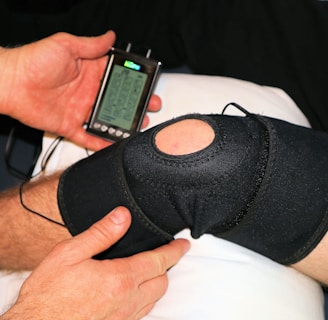Knee Pain Therapy: A Guide to Relief and Recovery
Knee pain is a common complaint that can significantly impact your daily activities. Whether it's caused by an injury, overuse, or underlying conditions, there are effective treatment options available. Here's a guide to knee pain therapy:
9/26/20241 min read


Knee pain is a common complaint that can significantly impact your daily activities. Whether it's caused by an injury, overuse, or underlying conditions, there are effective treatment options available. Here's a guide to knee pain therapy:
Common Causes of Knee Pain:
Injuries: Sprains, strains, fractures, and dislocations.
Overuse: Repetitive motions, such as running or jumping.
Arthritis: Osteoarthritis, rheumatoid arthritis, and gout.
Tendinitis: Inflammation of tendons.
Bursitis: Inflammation of bursae, fluid-filled sacs that cushion joints.
Meniscus tears: Tears in the cartilage that cushions the knee joint.
Effective Knee Pain Therapies:
Rest and Ice: Resting the affected knee and applying ice can help reduce inflammation and pain.
Compression and Elevation: Using a compression bandage and elevating the knee can help reduce swelling.
Over-the-Counter Pain Relief: Nonsteroidal anti-inflammatory drugs (NSAIDs) like ibuprofen or naproxen can alleviate pain and reduce inflammation.
Physical Therapy: A physical therapist can develop a customized exercise program to strengthen the muscles surrounding the knee, improve flexibility, and restore function.
Corticosteroid Injections: In severe cases, corticosteroid injections can help reduce inflammation and pain.
Braces and Supports: Knee braces or supports can provide stability and reduce stress on the joint.
Surgery: In some cases, surgery may be necessary to repair damaged cartilage, ligaments, or tendons.
When to Seek Medical Attention:
Severe pain: If you experience sudden, severe knee pain.
Inability to bear weight: If you cannot put weight on your knee.
Swelling or deformity: If your knee is swollen, deformed, or feels hot to the touch.
Locking or giving way: If your knee locks or feels like it is giving way.
Remember, it's essential to consult with a healthcare professional for a proper diagnosis and treatment plan. They can assess your specific condition and recommend the most appropriate therapies for your knee pain.
Vardaan Physio Clinic
Physiotherapy center in Lucknow, Uttar Pradesh
Contact
529 D/67, Tedhi Pulia Ring Rd, near Bank Of Baroda, Kalyanpur, Lucknow, Uttar Pradesh 226022
073111 33348
© 2024. All rights reserved.
